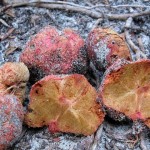Field Notes: Of Fungi, Rain Forests, and Birds
Posted in Science on May 18 2010, by Plant Talk
Garden Scientists Explore Biodiversity in Australia, Brazil, and Colombia
As environmental pressures increasingly put biodiversity at risk, one of the Garden’s most important goals is to lead in the effort to document every plant and fungal species on Earth. Garden scientists conduct research around the globe. Here are three recent reports from the field.
Roy Halling Returns to Fraser Island, Australia
In late March, Roy Halling, Ph.D., a specialist in mushrooms, continued his survey of macrofungi on Fraser Island, the largest of the world’s sand islands and a World Heritage Site off the east coast of Queensland, Australia. There he  and Nigel Fechner, a Senior Botanist at the Queensland Herbarium in Brisbane, found an undescribed genus of “false-truffle,” previously known only from Cape York, the northernmost part of Queensland. They discovered the fungus (pictured), about the size of a golf ball, protruding from a sand bank near Lake McKenzie. Scratching with a truffle rake in the sand and litter under a gum tree (Eucalyptus signata), they unearthed more of the bright red fungus. Like the truffle of commerce, this fungus has a strong penetrating odor, one of the key factors in attracting marsupials, which eat the fungus and disperse the spores in their scat.
and Nigel Fechner, a Senior Botanist at the Queensland Herbarium in Brisbane, found an undescribed genus of “false-truffle,” previously known only from Cape York, the northernmost part of Queensland. They discovered the fungus (pictured), about the size of a golf ball, protruding from a sand bank near Lake McKenzie. Scratching with a truffle rake in the sand and litter under a gum tree (Eucalyptus signata), they unearthed more of the bright red fungus. Like the truffle of commerce, this fungus has a strong penetrating odor, one of the key factors in attracting marsupials, which eat the fungus and disperse the spores in their scat.
The real gems for Halling on this trip were finding an exquisite species of Strobilomyces and a first report from Australia of a Heimioporus japonicus. This is the second known instance of a species in that genus in Australia.
Wayt Thomas Joins Partners in Brazil
Wayt Thomas, Ph.D., studies tropical American forests, especially the Atlantic forests of Brazil, one of the world’s biodiversity “hotspots.” He spent February in Brazil, working with colleagues from the Federal University of Paraiba and four other Brazilian universities studying the plants found in one of the most critically endangered rain forests in the world.
Two of the reserves Thomas visited on this trip protect submontane forests—moist forests at elevations of 1,300–2,600 feet. These two reserves are home to some of the world’s rarest birds, including the Alagoas Antwren, the Alagoas Foliage-gleaner, the Alagoas Tyrannulet, and the Orange-bellied Antwren. By comparing submontane forests with similar avifauna, he hopes to predict the occurrence of these rare birds in other areas.
Douglas Daly Travels to Colombia
Douglas Daly, Ph.D., returned to Colombia in January for the first time in 20 years to pursue his studies of the tropical tree family Burseraceae. He consulted eight herbaria in three cities and identified and annotated some 4,000 Burseraceae specimens in order to complete his treatment of the family for Colombia’s national flora checklist. Daly was able to secure permission to work in two localities on the western side of the Andes where small areas of primary forest remain. Although Colombia was in the grip of a severe drought, he collected more than 16 distinct species of Burseraceae, two of which he had never seen before, a tribute to the dizzying plant diversity of Colombia.

